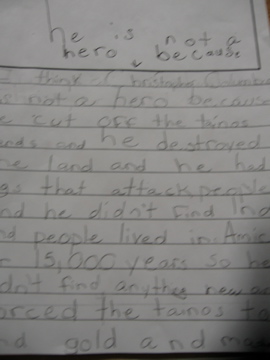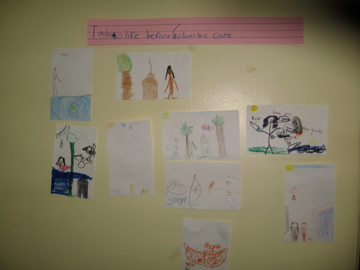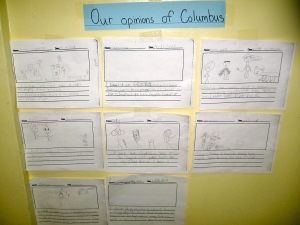Who is Columbus? And why does he have a day named after him?
One week before Columbus Day I was asked this by my second graders. I responded with a question – “Why do we have holidays?”
“Because something important happened a long time ago on that day.”
“Since Columbus is a person that must mean he is important or he did something important.”
“What did he do?”
I used their interest and questions to guide what I was going to teach them over the coming weeks. This was going to be a unit of discovery not on discovery.
Who is Columbus?
What is it that you remember about Christopher Columbus?
My guess is that it’s he was from Italy but sailed for Spain, had 3 ships-Nina, Pinta, and Santa Maria, and he sailed the ocean blue in 1492.
Those pretty useless facts are what I remembered learning too. I assumed that was the whole story for most of my life. That is until I reached college and learned the true story of Christopher Columbus and his “discovery”.
Through readings from Lies My Teacher Told Me by James Loewen and Rethinking Columbus by Bill Bigelow and Bob Peterson I was exposed to the full picture of Columbus’s journey. I learned fascinating facts that were absent from my 12 years of schooling. Things like Columbus made multiple trips to the new land and that he met indigenous people when he “discovered” the new land. As it turns out Columbus might not be so deserving of the hero status we have given him. While it is not known for sure that Columbus himself did any harm to the indigenous Taino people he met on his journey, it is well documented that his visit changed the life of the Taino people-and not for the better.
As you may or may not know Columbus went on his journey in search of gold. His thirst for gold convinced him that the Tainos had stores of it and were hiding it somewhere on the islands. The Tainos in fact, did not have hidden stores of gold, but nevertheless Columbus was convinced. The Tainos did however, have a rich culture and society. They worked together fairly peacefully, made sure all were able to eat and lived in harmony with the lush rainforests of the islands. Columbus, his men, and the governments set up after him enslaved the Tainos and forced them to work tirelessly to find the nonexistent gold.
A system was setup where those Tainos who were not able to fulfill their gold quota had their hands chopped off, and those who tried to run and escape were chased down and killed by attack dogs. The rainforests were destroyed and cleared to make room for forts and other buildings. Clearly, Taino life was changed forever.
You’d think a genocide might be addressed in the history books and probably the last thing one would have a holiday about-but you’d be wrong.
Knowing this information I knew I was not going to lie to my students. I was going to let them hear the whole story. Both sides. Then they could decide whether what Columbus did was heroic and holiday worthy or not.





























